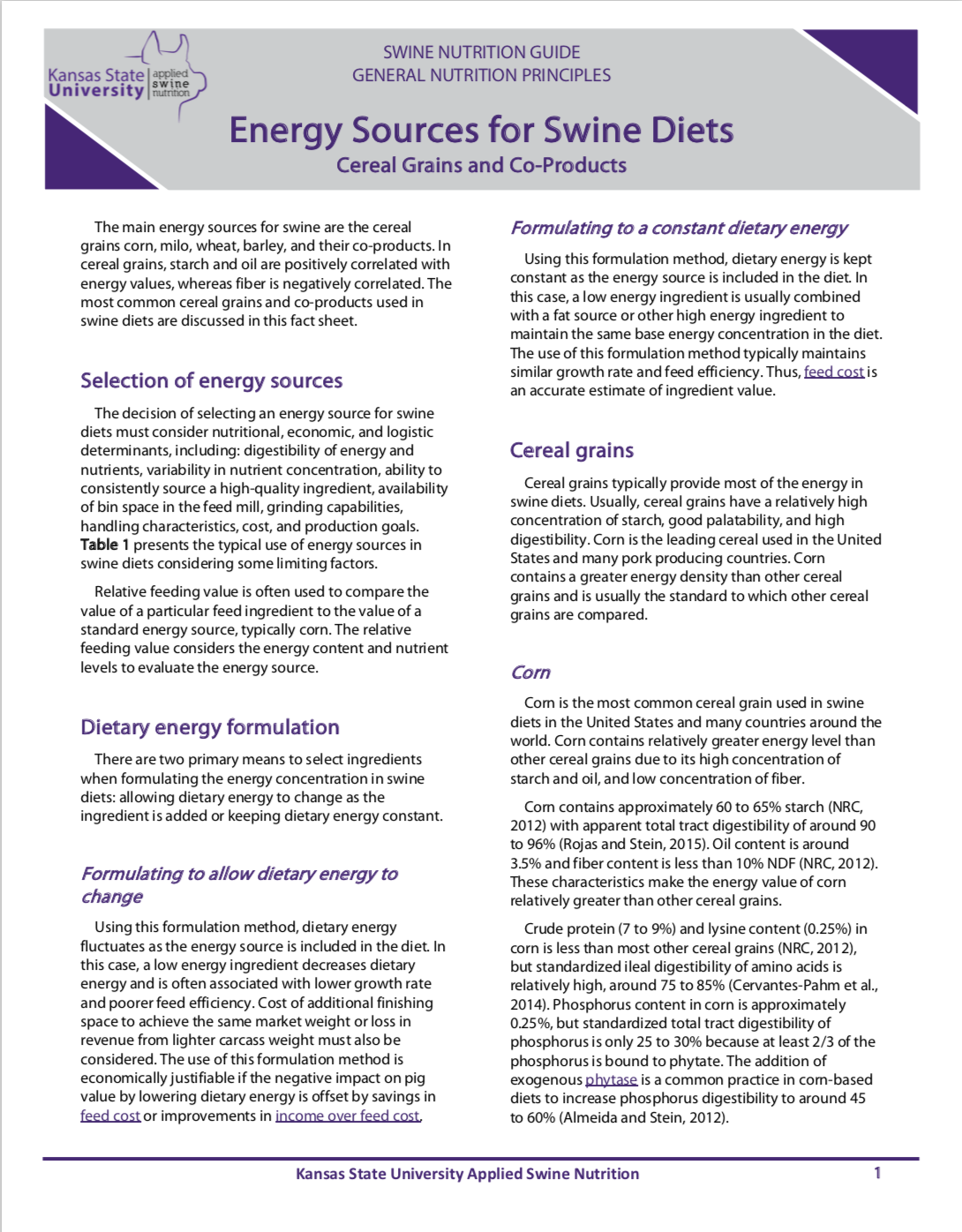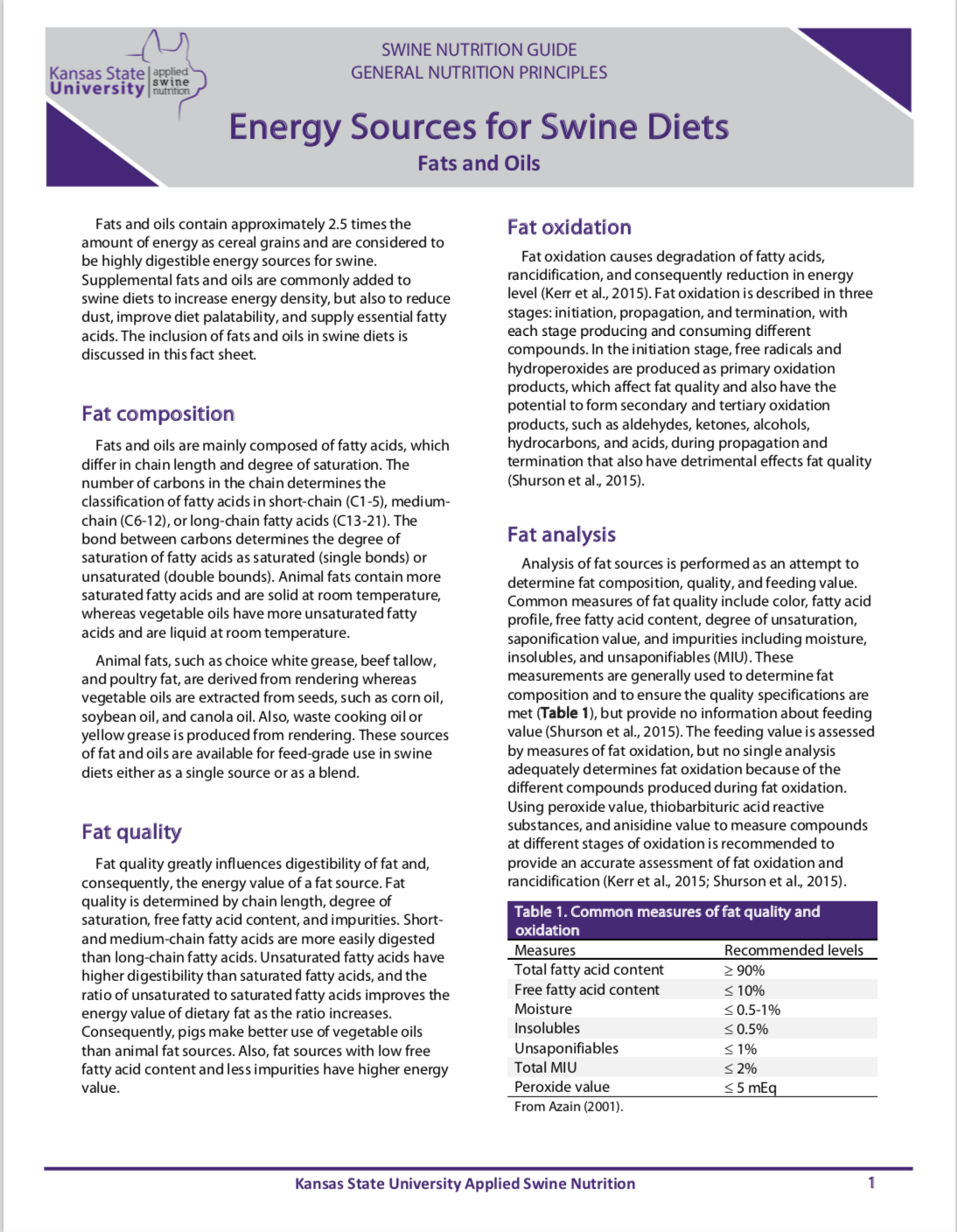Fats and oils
Fats and oils contain approximately 2.5 times the amount of energy as cereal grains and are considered to be highly digestible energy sources for swine. Supplemental fats and oils are commonly added to swine diets to increase energy density, but also to reduce dust, improve diet palatability, and supply essential fatty acids.
Fat composition
Fats and oils are mainly composed of fatty acids, which differ in chain length and degree of saturation. The number of carbons in the chain determines the classification of fatty acids in short-chain (C1-5), medium-chain (C6-12), or long-chain fatty acids (C13-21). The bond between carbons determines the degree of saturation of fatty acids as saturated (single bonds) or unsaturated (double bounds). Animal fats contain more saturated fatty acids and are solid at room temperature, whereas vegetable oils have more unsaturated fatty acids and are liquid at room temperature.
Animal fats, such as choice white grease, beef tallow, and poultry fat, are derived from rendering whereas vegetable oils are extracted from seeds, such as corn oil, soybean oil, and canola oil. Also, waste cooking oil or yellow grease is produced from rendering. These sources of fat and oils are available for feed-grade use in swine diets either as a single source or as a blend.
Fat quality
Fat quality greatly influences digestibility of fat and, consequently, the energy value of a fat source. Fat quality is determined by chain length, degree of saturation, free fatty acid content, and impurities. Short- and medium-chain fatty acids are more easily digested than long-chain fatty acids. Unsaturated fatty acids have higher digestibility than saturated fatty acids, and the ratio of unsaturated to saturated fatty acids improves the energy value of dietary fat as the ratio increases. Consequently, pigs make better use of vegetable oils than animal fat sources. Also, fat sources with low free fatty acid content and less impurities have higher energy value.
Fat oxidation
Fat oxidation causes degradation of fatty acids, rancidification, and consequently reduction in energy level (Kerr et al., 2015). Fat oxidation is described in three stages: initiation, propagation, and termination, with each stage producing and consuming different compounds. In the initiation stage, free radicals and hydroperoxides are produced as primary oxidation products, which affect fat quality and also have the potential to form secondary and tertiary oxidation products, such as aldehydes, ketones, alcohols, hydrocarbons, and acids, during propagation and termination that also have detrimental effects fat quality (Shurson et al., 2015).
Fat analysis
Analysis of fat sources is performed as an attempt to determine fat composition, quality, and feeding value. Common measures of fat quality include color, fatty acid profile, free fatty acid content, degree of unsaturation, saponification value, and impurities including moisture, insolubles, and unsaponifiables (MIU). These measurements are generally used to determine fat composition and to ensure the quality specifications are met ( Table 1 ), but provide no information about feeding value (Shurson et al., 2015). The feeding value is assessed by measures of fat oxidation, but no single analysis adequately determines fat oxidation because of the different compounds produced during fat oxidation. Using peroxide value, thiobarbituric acid reactive substances, and anisidine value to measure compounds at different stages of oxidation is recommended to provide an accurate assessment of fat oxidation and rancidification (Kerr et al., 2015; Shurson et al., 2015).
Measures of fat quality
- Color: ranging from 1 (light) to 45 (dark).
- Fatty acid profile: relative amount of individual fatty acids.
- Free fatty acid content: amount of fatty acids not bound to a carbon chain.
- Total fatty acid content: amount of free fatty acids and fatty acids bound to a carbon chain.
- Iodine value: estimate of degree of unsaturation, expressed as grams of iodine absorbed by 100 g of fat. The greater the iodine value, the greater the degree of unsaturation.
- Saponification value: estimate of fatty acid chain length, expressed as the amount of caustic soda needed to turn 1 g of fat into soap. The greater the saponification value, the lower the chain length.
- Moisture:amount of moisture.
- Insolubles: amount of materials that have no energy value, such as dirt, fiber, or hair.
- Unsaponifiables: amount of compounds that do not degrade upon mixing in alkaline solution, such as sterols, pigments, or vitamins.
Measures of fat oxidation
- Peroxide value (PV): estimate of peroxides and hydroperoxides produced during the initiation of fat oxidation.
- Thiobarbituric acid reactive substances (TBARS): estimate of malondialdehyde produced during propagation of fat oxidation.
- Anisidine value (AnV): estimate of aldehydes produced during propagation of fat oxidation.
Antioxidants
Antioxidants can be added to fats and oils to reduce fat oxidation, control rancidity, maintain palatability, and prolong storage time, particularly in diets with high amounts of fat or manufactured in warm climates. However, antioxidants cannot reverse fat oxidation once it occurs. Commercial antioxidant products commonly include ethoxyquin, butylated hydroxytoluene (BHT), butylated hydroxyanisole (BHA), propyl gallate, citric acid, ethylenediamine-tetra-acetic acid (EDTA), or a combination of these antioxidants (Kerr et al., 2015).
More information about the use of antioxidants in swine diets in Feed Additives in Swine Diets - Antioxidants.
Fat inclusion level
Fats are typically added up to 5% in swine diets. In the nursery, the addition of 3 to 4% fat is mainly used to improve the pelleting process of initial diets with high levels of lactose. In grow-finish diets, 1 to 5% fat is used to improve growth performance, with generally an improvement of feed efficiency close to 2% and average daily gain close to 1% for every 1% added fat. In lactation, 3 to 5% fat is used to increase dietary energy density. Fat is not typically added in gestation diets.
The addition of fat above 5% in meal diets normally leads to handling issues due to bridging of feeders and caking of mixers, whereas in pelleted diets leads to inferior pellet quality. Diets containing high levels of added fat are also predisposed to become rancid during prolonged storage or exposure to high temperatures.
The fat inclusion level should be based on an economic analysis to determine the most economical level considering the value of incremental changes in energy on production indicators and the market price. A production tool has been developed to aid in determining the dietary energy level in the grow-finish phase (Net Energy Model)
Fat use by the pig
The digestibility of fat is low in weanling pigs but the ability to digest fat increases with age, particularly for animal fats compared with vegetable oils. The young pig seems to require a more digestible fat sources rich in unsaturated and short-chain fatty acids for efficient energy utilization than the growing-finishing pig (Gu and Li, 2003). Vegetable oils like soybean oil and coconut oil are high quality sources of energy for weanling pigs (Weng, 2016), but are typically more expensive compared to animal sources like choice white grease.
The pig deposits fat in the same fatty acid profile as the dietary fat. This characteristic is particularly important in growing-finishing pigs because the composition of dietary fat is a determinant of carcass fat quality. Diets with vegetable oils are rich in unsaturated fatty acids and increase the iodine value and softness of carcass fat. The iodine value estimates the degree of unsaturation of carcass fat, with higher iodine value associated with softer pork fat (Benz et al., 2011). Soft pork fat is undesirable because it affects the ability to process pork bellies and to meet specifications of fresh cuts of pork. Some pork processing plants have established a maximum allowable iodine value cutoff, which may limit the amount of fat sources, especially unsaturated fats or oils, in finishing diets.


